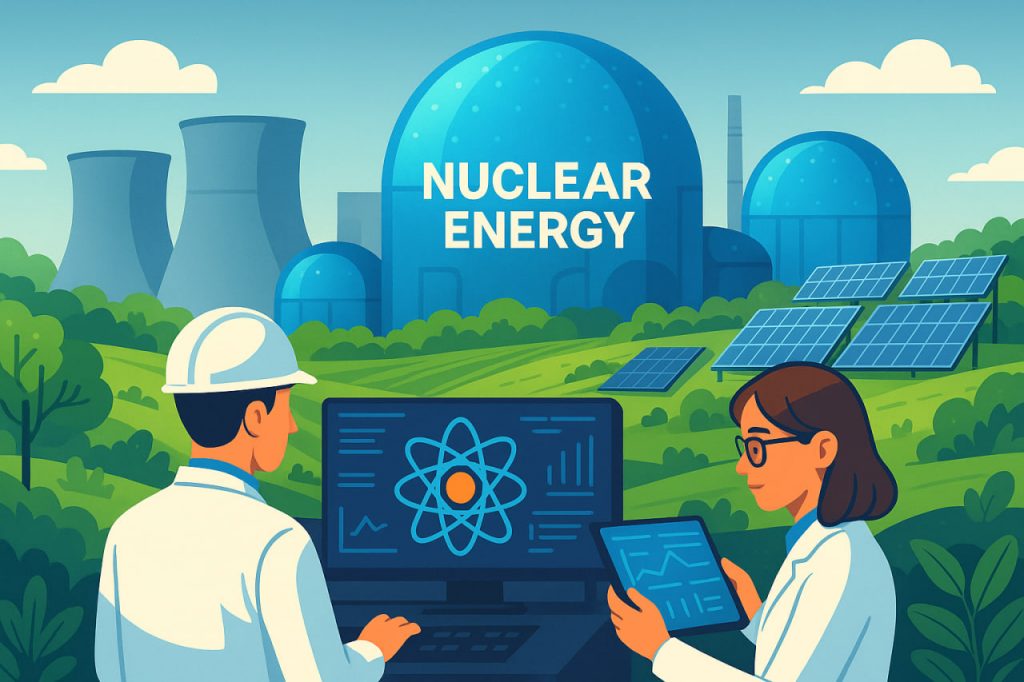Nuclear energy stands at a crossroads between innovation and caution. Once seen as the energy source of the future, it later became a symbol of fear after disasters like Chernobyl and Fukushima. Yet, as the world faces the urgent challenge of climate change, nuclear power is reemerging as a key part of the global conversation. It offers immense potential for clean, stable energy—if humanity can harness it safely and sustainably. The future of nuclear energy may well define the balance between technological progress and environmental responsibility.
The Promise of Nuclear Energy
Nuclear energy is one of the most efficient sources of power ever developed. A single uranium fuel pellet—about the size of a fingertip—produces as much energy as one ton of coal or 150 gallons of oil. Unlike fossil fuels, nuclear power emits no carbon dioxide during operation, making it a critical ally in the fight against global warming. According to the International Atomic Energy Agency (IAEA), nuclear plants currently supply about 10% of global electricity and nearly 25% of low-carbon energy worldwide. As nations strive to reach net-zero emissions, advanced nuclear technologies could play a vital role in meeting those goals.
The Challenges Ahead
Despite its potential, nuclear energy faces several obstacles: public fear, high costs, and the long-term issue of radioactive waste disposal. Accidents from past decades continue to shape public perception, even though modern reactors are far safer. Financially, nuclear plants require billions in investment and decades to build. Additionally, spent fuel must be stored securely for thousands of years. Governments and scientists are exploring deep geological repositories, such as Finland’s Onkalo facility, to safely contain radioactive materials far below Earth’s surface.
Next-Generation Reactors
The future of nuclear power depends on innovation. Scientists are developing small modular reactors (SMRs)—compact, scalable systems that offer lower risk and easier maintenance. Unlike traditional large reactors, SMRs can be factory-built and transported to remote areas, providing power to communities or industries without massive infrastructure. Some new designs, such as molten salt reactors and fast neutron reactors, promise to use fuel more efficiently and produce less waste. These technologies also include passive safety systems that automatically shut down reactors in emergencies without human intervention.
The Dream of Nuclear Fusion
The holy grail of energy research is nuclear fusion, the process that powers the Sun. Fusion combines light atoms (like hydrogen) into heavier ones, releasing enormous energy without producing long-lived radioactive waste. Scientists have been pursuing this breakthrough for decades, and progress is accelerating. The ITER project in France—the world’s largest fusion experiment—aims to demonstrate that sustained fusion power is achievable. If successful, fusion could revolutionize global energy, providing virtually limitless clean power. However, experts estimate that commercial fusion plants may still be 20–30 years away.
Balancing Risk and Responsibility
Safety remains the cornerstone of nuclear energy’s future. Modern designs incorporate multiple layers of containment, digital monitoring, and advanced materials resistant to corrosion and heat. Nations like France, South Korea, and Canada demonstrate that nuclear power can operate safely with strong regulatory oversight. According to Dr. Allison Macfarlane, former chair of the U.S. Nuclear Regulatory Commission, “The question is not whether nuclear power can be safe—it’s whether we manage it transparently and responsibly.”
The Role of Nuclear Energy in a Green Future
Renewable sources like solar and wind are essential, but their intermittency poses challenges. Nuclear energy offers a stable complement—producing continuous baseload power that supports the electrical grid when renewables fluctuate. Hybrid energy systems combining nuclear and renewables could create a balanced and resilient energy mix. Additionally, nuclear power can drive hydrogen production, desalination, and even space exploration. NASA is already testing compact nuclear systems for future missions to Mars and the Moon.
Global Perspectives and Public Acceptance
Public opinion about nuclear energy varies widely. In countries like France, it is seen as a source of national pride and clean energy independence. In others, such as Germany, it has been phased out entirely due to political and environmental concerns. Experts argue that public education is vital—understanding the science behind nuclear energy can replace fear with informed decision-making. International cooperation through organizations like the IAEA ensures that nations share best practices, improving global safety and transparency.
The Ethics of Energy Choice
The moral dimension of nuclear power cannot be ignored. Humanity must weigh short-term risks against long-term survival. Fossil fuels are causing climate damage on a planetary scale, while nuclear power—despite its dangers—offers a potential solution. Ethicists argue that responsible nuclear use, guided by strict regulation and public accountability, may be an ethical necessity to sustain life on Earth. The future depends not just on technology but on our ability to wield it wisely.
Interesting Facts
- A single nuclear plant can power millions of homes continuously without emitting carbon dioxide.
- The Onkalo repository in Finland will safely store radioactive waste for up to 100,000 years.
- Modern nuclear reactors can reuse spent fuel, reducing waste by up to 90%.
- Fusion energy releases four million times more energy per kilogram of fuel than coal.
- France gets over 70% of its electricity from nuclear power, the highest percentage in the world.
Glossary
- Nuclear Fission – The splitting of atomic nuclei to release energy.
- Nuclear Fusion – The process of combining atomic nuclei to produce energy, as in stars.
- Radioactive Waste – Byproducts of nuclear reactions that emit radiation.
- Small Modular Reactor (SMR) – A compact, factory-built nuclear reactor designed for safety and flexibility.
- Onkalo Facility – Finland’s underground repository for long-term nuclear waste storage.
- Baseload Power – Continuous energy supply that meets constant demand.
- Passive Safety System – A safety feature that operates without human input or power.
- Decommissioning – The safe shutdown and dismantling of nuclear plants.
- Molten Salt Reactor – A reactor using liquid fuel and coolant for higher efficiency and safety.
- ITER Project – The world’s largest nuclear fusion experiment located in southern France.


